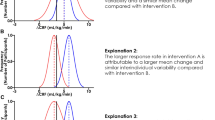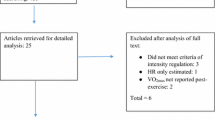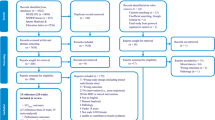Abstract
It has recently been reported how to quantify inter-individual differences in the response to an exercise intervention using the standard deviation of the change scores, as well as how to appraise these differences for clinical relevance. In a parallel-group randomised controlled trial, the key trigger for further investigation into inter-individual responses is when the standard deviation of change in the intervention sample is substantially larger than the same standard deviation derived from a suitable comparator sample. ‘True’ and clinically relevant inter-individual differences in response can then be plausibly expected, and potential moderators and mediators of the inter-individual differences can be explored. We now aim to critically review the research on the inter-individual differences in response to exercise training, focusing on maximal oxygen uptake (VO2max). A literature search through the relevant bibliographic databases resulted in the identification of six relevant studies that were published prior to the influential HEalth, RIsk factors, exercise Training And GEnetics (HERITAGE) Family Study. Only one of these studies was found to include a comparator arm. Re-analysis of the data from this study, accounting for random within-subjects variation, revealed an absence of clinically important inter-individual differences in the response of VO2max to exercise training. The standard deviation of change was, in fact, larger (±5.6 mL/kg/min) for the comparator than the intervention group (±3.7 mL/kg/min). We located over 180 publications that resulted from the HERITAGE Family Study, but we could not find a comparator arm in any of these studies. Some authors did not explain this absence, while others reasoned that only inter-individual differences in exercise response were of interest, thus the intervention sample was investigated solely. We also found this absence of a comparator sample in on-going studies. A perceived high test–retest reliability is offered as a justification for the absence of a comparator arm, but the test–retest reliability analysis for the HERITAGE Family Study was over a much shorter term than the length of the actual training period between baseline and follow-up measurements of VO2max. We also scrutinised the studies in which twins have been investigated, resulting in concerns about how genetic influences on the magnitude of general within-subjects variability has been partitioned out (again in the absence of a comparator no-training group), as well as with the intra-class correlation coefficient approach to data analysis. Twin pairs were found to be sometimes heterogeneous for the obviously influential factors of sex, age and fitness, thereby inflating an unadjusted coefficient. We conclude that most studies on inter-individual differences in VO2max response to exercise training have no comparator sample. Therefore, true inter-individual differences in response cannot be quantified, let alone appraised for clinical relevance. For those studies with a comparator sample, we found that the inter-individual differences in training response were not larger than random within-subjects variation in VO2max over the same time period as the training intervention.

Similar content being viewed by others
References
Prud’Homme D, Bouchard C, LeBlanc C, et al. Sensitivity of maximal aerobic power to training is genotype-dependent. Med Sci Sports Exerc. 1984;16:89–93.
Despres JP, Bouchard C, Savard R, et al. The effect of a 20-week endurance training program on adipose-tissue morphology and lipolysis in men and women. Metabolism. 1984;33:235–9.
Lortie G, Simoneau JA, Hamel P, et al. Responses of maximal aerobic power and capacity to aerobic training. Int J Sports Med. 1984;5:232–6.
Savard R, Despres JP, Marcotte M, et al. Endurance training and glucose conversion into triglycerides in human fat cells. J Appl Physiol. 1985;1985(58):230–5.
Hamel P, Simoneau J, Lortie G, et al. Heredity and muscle adaptation to endurance training. Med Sci Sports Exerc. 1986;18:690–6.
Simoneau JA, Lortie G, Boulay MR, et al. Inheritance of human skeletal muscle and anaerobic capacity adaptation to high-intensity intermittent training. Int J Sports Med. 1986;7:167–71.
Rose EA, Partfitt G. A quantitative and qualitative explanation of the individual differences in affective responses to prescribed and self-selected exercise intensities. J Sport Exerc Psychol. 2007;29:281–309.
Senn S, Rolfe K, Julious SA. Investigating variability in patient response to treatment: a case study from a replicate cross-over study. Stat Methods Med Res. 2011;20:657–66.
Bouchard C. Genomic predictors of trainability. Exp Physiol. 2012;97:347–52.
Bouchard C, Antunbes-Correa LM, Ashley EA, et al. Personalised preventive medicine: genetics and the response to regular exercise in preventive interventions. Prog Cardiovasc Dis. 2015;57:337–46.
Mann TN, Lamberts RP, Lambert MI. High responders and low responders: factors associated with individual variation in response to standardized training. Sports Med. 2014;44:1113–24.
Spear BB, Heath-Chiozzi M, Huff J. Clinical applications of pharmacogenetics. Trends Mol Med. 2001;7:201–4.
Bouchard C, Rankinen T. Individual differences in response to regular physical activity. Med Sci Sports Exerc. 2001;33(S6):S452–3.
Senn S. Individual response to treatment: is it a valid assumption? BMJ. 2004;329:966–8.
Karavirta L, Hakkinen K, Kauhanen A, et al. Individual responses to combined endurance and strength training in older adults. Med Sci Sports Exerc. 2011;43:484–90.
Bouchard C. Human adaptability may have a genetic basis. In: Landry F, editor. Health and risk estimation, risk reduction and health promotion. Proceedings of the 18th Annual Meeting of the Society of Prospective Medicine. Ottawa: Canadian Public Health Association; 1983. p. 463–76.
Hautala AJ, Makikallio TH, Kiviniemi A, et al. Cardiovascular autonomic function correlates with the response to aerobic training in healthy subjects. Am J Physiol Heart Circ Physiol. 2003;285:1747–52.
Hopkins W. Individual responses made easy. J Appl Physiol. 1985;2015(118):1444–6.
Atkinson G, Batterham A. True and false interindividual differences in the physiological response to an intervention. Exp Physiol. 2015;100:577–88.
Hecksteden A, Krauscher J, Scharhag-Rosenberger F, et al. Individual response to exercise training: a statistical perspective. J Appl Physiol. 1985;2015(118):1450–9.
Senn S. Mastering variation: variance components and personalised medicine. Stat Med. 2016;35:966–77.
Laukkanen JA, Kurl S, Salonen R, et al. The predictive value of cardiorespiratory fitness for cardiovascular events in men with various risk profiles: a prospective, population based cohort study. Eur Heart J. 2004;25:1428–37.
Sui X, LaMonte MJ, Blair SN. Cardiorespiratory fitness as a quantitative predictor of non-fatal cardiovascular events in asymptomatic men and women. Am J Epidemiol. 2007;165:413–23.
Myers J, Prakash M, Froelicher V, et al. Exercise capacity and mortality among men referred for exercise testing. N Engl J Med. 2002;346:793–801.
Church TS, Earnest CP, Skinner JS, et al. Effects of different doses of activity on cardiorespiratory fitness among sedentary, overweight or obese postmenopausal women with elevated blood pressure: a randomized control trial. JAMA. 2007;297:2081–91.
Kelley GA, Kelley KS. Efficacy of aerobic exercise on coronary heart disease risk factors. Prev Cardiol. 2008;11:71–5.
Church TS, Blair SN, Cocreham S, et al. Effects of aerobic and resistance training on hemoglobin A1c levels in patients with type 2 diabetes: a randomized control trial. JAMA. 2010;304:2253–62.
Jette M, Sidney K, Blumchen G. Metabolic equivalents (METS) in exercise testing, exercise prescription, and evaluation of functional capacity. Clin Cardiol. 1990;13:555–65.
Bouchard C. Individual differences in the response to regular exercise. Int J Obes Relat Metab Disord. 1995;19(Suppl. 4):S5–8.
Feitosa MF, Gaskill SE, Rice T, et al. Major gene effects on exercise ventilatory threshold: the HERITAGE Family Study. J Appl Physiol. 1985;2002(93):1000–6.
Vollaard NBJ, Constantin-Teodosiu D, Fredriksson K, et al. Systematic analysis of adaptations in aerobic capacity and submaximal energy metabolism provides a unique insight into determinants of human aerobic performance. J Appl Physiol. 1985;2009(106):1479–86.
Bouchard C, Blair CN, Church TS, et al. Adverse metabolic response to regular exercise: is it a rare or common occurrence? PLoS One. 2012;7(5):e37887.
Leifer ES, Mikus CR, Karavirta L, et al. Adverse cardiovascular response to aerobic exercise training: is this a concern? Med Sci Sports Exerc. 2015;48:20–5.
Kainulainen H. Run more, perform better: old truth revisited. J Appl Physiol. 1985;2009(106):1477–8.
Rankinen T, Argyropoulos G, Rice T, et al. CREB1 is a strong genetic predictor of the variation in exercise heart rate response to regular exercise: the HERITAGE Family Study. Circ Cardiovasc Genet. 2010;3:294–9.
Timmons JA, Knudsen S, Rankinen T, et al. Using molecular classification to predict gains in maximal aerobic capacity following endurance exercise training in humans. J Appl Physiol. 1985;2010(108):1487–96.
Bouchard C, Lesange R, Lortie G, et al. Aerobic performance in brothers, dizygotic and monozygotic twins. Med Sci Sports Exerc. 1986;18:639–45.
Kohrt WM, Malley MT, Coggan AR, et al. Effects of gender, age, and fitness level on response of VO2max to training in 60–71 year-olds. J Appl Physiol. 1985;1991(71):2004–11.
Wilmore JH, Stanforth PR, Gagnon J, et al. Heart rate and blood pressure changes with endurance training: the HERITAGE Family Study. Med Sci Sports Exerc. 2000;33:107–16.
Bouchard C, Wolfarth B, Rivera MA, et al. Genetic determinants of endurance performance. In: Shephard RJ, Astrand PO, editors. Endurance in sport: encyclopaedia of sports medicine. Oxford: Blackwell Scientific; 2000. p. 223–42.
Gagnon J, Province MA, Bouchard C, et al. The HERITAGE Family Study: quality assurance and quality control. Ann Epidemiol. 1996;6:520–9.
Sisson SB, Katzmaryk PT, Earnest CP, et al. Volume of exercise and fitness non-response in sedentary post-menopausal women. Med Sci Sports Exerc. 2009;41:539–45.
Pandey A, Ayers C, Blair SN, et al. Cardiac determinants of heterogeneity in fitness change in response to moderate intensity aerobic exercise training. J Am Coll Cardiol. 2015;65:1057–8.
Ross R, de Lannoy L, Stotz PJ. Separate effects of intensity and amount of exercise on interindividual cardiorespiratory fitness response. Mayo Clin Proc. 2015;90:1506–14.
Bennette C, Vickers A. Against quartiles: catergorization of continuous variables in epidemiologic research, and its discounts. BMC. 2012;12:1. doi:10.1186/1471-2288-12-21.
Hautala AJ, Kiviniemi AM, Makikallio TH, et al. Individual differences in the responses to endurance and resistance training. Eur J Appl Physiol. 2006;96:535–42.
Scharhag-Rosenberger F, Walitzek S, Kindermann W, et al. Differences in adaptations to 1 year of aerobic endurance training: individual patterns of nonresponse. Scand Med Sci Sports. 2012;22:113–8.
Senn S. Individual therapy: new dawn or false dawn? Drug Info J. 2001;35:1479–94.
Bouchard C, An P, Rice T, et al. Familial aggregation of VO2max response to exercise training: results from the HERITAGE study. J Appl Physiol. 1985;1999(87):1003–8.
Skinner JS, Jaskolski A, Jaskolska A, et al. Age, sex, race, initial fitness and response to training: the HERITAGE Family Study. J Appl Physiol. 1985;2001(90):1770–6.
Buford TW, Roberts MD, Church TS. Toward exercise as personalised medicine. Sports Med. 2013;43:157–65.
Bouchard C, Leon AS, Rao DC, et al. The HERITAGE Family Study: aims, design and measurement protocol. Med Sci Sports Exerc. 1995;27:721–9.
Bouchard C, Rankinen T, Chagnon YC, et al. Genomic scan for maximal oxygen uptake and its response to training in the HERITAGE Family Study. J Appl Physiol. 1985;2000(88):551–9.
Perusse L, Gagnon J, Province MA, et al. Familial aggregation of submaximal aerobic performance in the HERITAGE Family Study. Med Sci Sports Exerc. 2001;33:597–604.
Bouchard C, Sarzynski MA, Rice TK, et al. Genomic predictors of the maximal O2 uptake response to standardized exercise training programs. J Appl Physiol. 2011;110:1160–70.
Bouchard C, Daw E, Warwick E, et al. Familial resemblance for VO2max in the sedentary state: the HERITAGE Family Study. Med Sci Sports Exerc. 1998;30:252–8.
Gaskill SE, Rice T, Bouchard C, et al. Familial resemblance in ventilatory threshold: the HERITAGE Family Study. Med Sci Sports Exerc. 2001;233:1832–40.
Montoye HJ, Gayle R. Familial relationships in maximal oxygen uptake. Hum Biol. 1978;50:241–9.
Lesage RJA, Simoneau J, Jobin J, et al. Familial resemblance in maximal heart rate, blood lactate and aerobic power. Hum Hered. 1985;35:182–9.
Maes HHM, Neale MC, Eaves LJ. Genetic and environmental factors in relative body weight and human adiposity. Behav Genet. 1997;27:325–51.
Poehlman ET, Tremblay A, Despres JP, et al. Genotype-controlled changes in body composition and fat morphology following overfeeding in twins. Am J Clin Nutr. 1986;43:723–31.
Bouchard C, Tremblay A, Despres JP, et al. The response to long-term overfeeding in identical twins. N Engl J Med. 1990;322:1477–82.
Heller DA, De Faire U, Pederson NL, et al. Genetic and environmental influences on serum lipid levels in twins. N Engl J Med. 1993;328:1150–6.
Bouchard C, Tremblay A, Despres JP, et al. The response to exercise with constant energy intake in identical twins. Obes Res. 1994;2:400–10.
Hong Y, Pederson NL, Brismar K, et al. Genetic and environmental architecture of the features of the insulin-resistance syndrome. Am J Hum Genet. 1997;60:143–52.
Tremblay A, Poehlman ET, Despres JP, et al. Endurance training with constant energy intake in identical twins: changes over time in energy expenditure and related hormones. Metabolism. 1997;46:499–503.
Segal NL, Allison DB. Twins and virtual twins: bases of relative body weight revisited. Int J Obes Metab Disord. 2002;26:437–41.
Chiolero A, Paradis G, Rich B, et al. Assessing the relationship between the baseline value of a continuous variable and subsequent change over time. Front Public Health. 2013;1:1–8.
Blomqvist N, Svardsudd K. A new method for investigating the relation between change and initial value in longitudinal blood pressure data. II. Comparison with other methods. Scand J Soc Med. 1978;6:125–9.
Shephard RJ, Rankinen T, Bouchard C. Test-retest errors and the apparent heterogeneity of training responses. Eur J Appl Physiol. 2004;91:199–203.
Skinner JS, Wilmore KM, Jaskolska A, et al. Reproducibility of maximal exercise test data in the HERITAGE Family Study. Med Sci Sports Exerc. 1999;31:1623–8.
Guyatt GH, Heyting A, Jaeschke R, et al. N-of-1 randomized trials for investigating new drugs. Control Clin Trials. 1990;11:88–100.
Lillie EO, Patay B, Diamant J, et al. The n-of-1 clinical trial: the ultimate strategy for individualizing medicine? Per Med. 2011;8:161–73.
Senn S. Suspended judgement of n-of-1 trials. Control Clin Trials. 1993;14:1–5.
Zucker DR, Ruthazer R, Schmid CH. Individual (n-of-1) trials can be combined to give population comparative treatment effect estimates: methodologic considerations. J Clin Epidemiol. 2010;63:1312–23.
Batterham AM, Hopkins WG. Making meaningful inferences about magnitudes. Int J Physiol Perform. 2006;1:50–7.
Hopkins WH. Precision of the estimate of a subject’s true value (Excel spreadsheet). In: a new view of statistics. Internet society for sport science. 2000. www.sportsci.org/resource/stats/xprecisionsubject.xls. Accessed 21 Nov 2016.
Author information
Authors and Affiliations
Corresponding author
Ethics declarations
Funding
No sources of funding were used in the preparation of this article.
Conflict of interest
Philip J. Williamson, Greg Atkinson and Alan M. Batterham declare that they have no conflicts of interest that are relevant to the content of this review.
Rights and permissions
About this article
Cite this article
Williamson, P.J., Atkinson, G. & Batterham, A.M. Inter-Individual Responses of Maximal Oxygen Uptake to Exercise Training: A Critical Review. Sports Med 47, 1501–1513 (2017). https://doi.org/10.1007/s40279-017-0680-8
Published:
Issue Date:
DOI: https://doi.org/10.1007/s40279-017-0680-8




